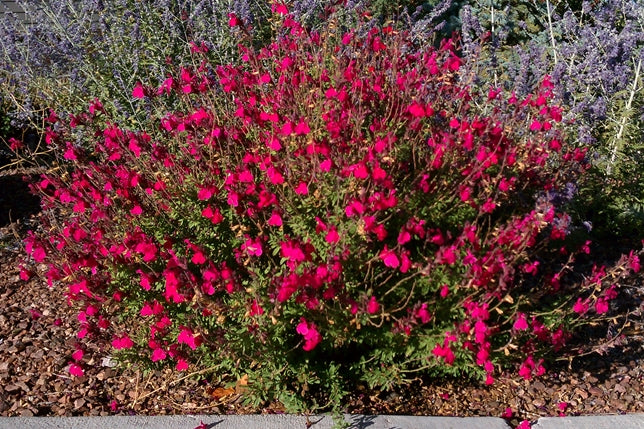by Ken Lain, the mountain gardener
The longest blooming sage in crimson-red that signals spring with continual flowers that broadcast right through Autumn. Hummingbirds and gardeners alike fall for this knee-high bloomer that deserves a prominent location in the garden’s hotter spots. Keep lightly clipped for a low informal hedge or a single specimen in borders or courtyard containers. Javelina and deer-proof.

Autumn Sage is a Southwest native growing wild in Texas, New Mexico, and Arizona. It is a small, deciduous shrub that grows to 3′ feet tall and wide. Its small, dark green leaves have a slightly sticky coating. Brightly flavored 1inch long flowers appear on 6-10 inch long spikes Spring through Autumn. Autumn Sage is available in a wide range of flower colors, including red, pink, fuchsia, purple, orange, yellow, and white. The hot pink and the Fuschia flowering varieties are the most heat tolerant.
Its compact size, rich green leaves, long bloom period, and hummingbird’s profusion attracting flowers have made this little shrub a mainstay in the Southwestern garden. Use Autumn Sage in container gardens, planters, or as a border for landscape color.
Botanical name: Salvia greggii
Common names: Autumn sage, Autumn Salvia, Cherry Sage, Gregg salvia, Red Chihuahuan sage, Texas red sage
Size: 3’x3′ feet
Flowers: Red, white, yellow, orange, salmon, fuchsia, purple, red-violet and burgundy
Bloom time: Spring through Autumn
Leaves: Small, pale green with a sagy aromatic fragrance
Growing Zone: 7-11
Flowers: 1″ inch flowers with a distinct hump on top of its upper lip, a flared two-lobed lower lip at a right angle, fragrant and edible.
Problems: Resistant to damage from pests, disease, and animals like deer, elk, and javelina. In summer, spittlebug has been witnessed.
Wildlife: Attracts hummingbirds and butterflies.
Maintenance
Autumn Sage grows best when placed in full sun in the mid-elevation zones of Arizona, including Tucson. Place it in light shade in the low elevations. Autumn Sage should be planted in a soil that has good drainage. It is susceptible to spittlebug. This is controlled by spraying Watters Multi-Purpose Insect Spray on the infected areas.
How to Grow Autumn Sage
Autumn sage works well in containers, borders, or mass plantings. The branches originate near the base of the plant resulting in a vase-shaped appearance. Small 1-inch flowers from spring through fall. It tolerates heat and requires little supplemental water after the plant is established. The historically red-flowered plant has been enhanced, and varieties of colors are now available. Salvia is adaptable to many garden soils and is attractive to both hummingbirds and butterflies.
Light
For your Autumn Sage plant to bloom to its potential, it needs about six hours a day of full sun.
Soil
Soil should be rich and well-drained for best bloom.
Water
New plants will need water to establish, so make sure they are adequately watered. A small plant with fewer leaves needs less water than a large leafy plant in full bloom. Through summer, give your sage a deep soak twice per week. This can be cut back to once per week if a monsoon rain occurs. You should water this plant twice per month in winter or when the soil is dry to the touch.
Fertilizer
Growing Autumn Sage needs plenty of nutrients. Feed with 7-4-4 All Purpose Food three times per year for amazing flowers. This natural food is spread like salt-and-pepper around the plant’s base every Easter, July 4th, and Halloween for incredible results.
For big, show-stopping flowers, you want to plant the following cultivars:
Radio Red – The brightest red of all the sages
Glimmer Heatwave is a new pure white that sparkles in the gardens.
Ignition Purple is the latest purple to arrive on the market
Furmans Red is the variety that started the Autumn Sage craze
Pruning
Salvia prefers being pruned in late winter and early spring before new leaves form. March is the ideal month to shape and prune this woody perennial shrub. Autumn sage does benefit from pruning in mid-summer and reinvigorate the plant. Pruning in mid-summer encourages a second flush of massive blooms.
Growing in Containers
If you are growing Autumns Sage in a container, be sure to plant it in a pot with adequate drainage holes. Fill the post with Watters Potting Soil and plant directly into this super, growing medium.

